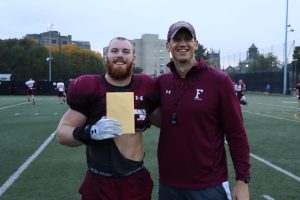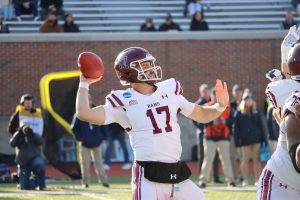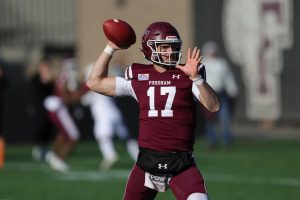“We are all Human”
Damar Hamlin Accident Sends Shockwaves Through Fordham Football Players
SCHLETM VIA WIKIMEDIA COMMONS
Damar Hamlin is removed from the field by an ambulance as Bills and Bengals players kneel.
January 19, 2023
During what was at first a typical Monday Night Football game on Jan. 2, Buffalo Bills safety Damar Hamlin suffered a cardiac arrest after just 15 minutes of play. It appeared to be a routine hit in the chest from the shoulder of Cincinnati Bengals receiver Tee Higgins. Hamlin stood up but fell to the ground once he took a few steps.
His heartbeat was restored on the field, but he was then rushed to University of Cincinnati Medical Center, where he was reported to be in critical condition. There’s no question that Hamlin’s accident generated a global response, but how is the future generation of football faring?
Although the entire world felt the impact of Hamlin’s accident, young, up-and-coming football players in particular were emotional.
“Our team group chat was blowing up,” Rams defensive back John O’Friel, Fordham College at Rose Hill (FCRH) ’23, said. “I can’t imagine if it were one of my own teammates going through that.”
“As a football player, you always have that thought in the back of your mind that something can go wrong.” Dequece Carter, GSBRH ’23 and Rams wide receiver
O’Friel emphasized the closeness of his team, saying that he spends more time with the Rams than his family. These men undergo preseasons, workouts and bonding activities with their teammates to the point where they see each other as brothers.
“It’s a bond that’s hard to explain,” O’Friel said. “If that were my teammate going through something traumatic on the field, I would be all over the place.”
Rams are not just friends on the field, but off the field as well. Rams defensive line and long snapper Tom Callahan, Gabelli School of Business at Rose Hill (GSBRH) ’23, explained that the football players do almost everything together, such as “live together, do homework, eat in the dining hall, go to class, play video games, go out and lift weights.”
Rams wide receiver Dequece Carter, GSBRH ’23, said that the fraternity among players, particularly across opposing teams, goes unnoticed. “A lot of players probably have crossed paths before, whether going through little league, high school or college,” Carter said. “It’s all love. Everyone out there loves playing football. We all look out for each other.”
“People put so much pressure on players. Especially in schools that play on a more national level, players are treated like products.” John O’Friel, FCRH ’23 and Rams defensive back
He added that he has several friends on different teams he follows on Instagram. “I’ve been on fields where, as we game, we’re dapping up guys on the other team or exchanging jerseys,” Carter said. “I can only imagine, seeing someone down on the other team would hurt just as bad as one of your own guys going down.”
Carter admitted that watching Hamlin down on the field was terrifying, even though injury is a risk he signed up for as an athlete. “I’ve been on a field where people broke their legs and arms or were knocked out. But I’ve never been on a field where someone was in a life-or-death situation,” he said. “As a football player, you always have that thought in the back of your mind that something can go wrong.”
However, despite his fear, he said that he never doubted his own dedication to the sport. “We all know that football is a violent sport, and we continue to play for the love of the game and for our brothers,” he said.
Rams kicker Michael Bernard, GSBRH ’23, agreed. “Although I won’t stop playing football, I will never take a moment with my teammates for granted again,” he said. “Hopefully, this event will spark more research about how to limit the risk of terrible moments like these in athletes.”
Some Rams also emphasized a desire for people to see football players as human and understand their limits. College-level athletes are often signed on for television deals and used for ticket sales and merchandise, creating high expectations for them. “We’re not superhuman,” O’Friel said. “People put so much pressure on players. Especially in schools that play on a more national level, players are treated like products.”
As the Rams consider a future career in football, they want to ensure their humanity isn’t overlooked. Hamlin, for example, hosted his third annual toy drive for children in his community through his foundation, Chasing M’s. While its initial fundraising goal was $2,500, just hours after Hamlin’s collapse, the charity surpassed $4 million in donations. The donor dollars were symbolic — they represented a shift in mindset. No longer were people betting on Hamlin, the teammate. They were placing their faith in Hamlin, the individual, and his mission to make the world a better place.
“The players on the football field are more than the names and numbers on their jerseys,” Callahan said. “We have families, friends and lives on and off the field. While players are strong and talented, we are all human.”
















Angela-Filomena LoCascio • Jan 24, 2023 at 6:17 pm
Not only am I a PCS student and a staff writer for the Observer; I am the mother of a 34 year old man who played football for his high school team and as he did not go to college, John played for a non for profit team who worked with young men who were youths in crisis. The team was amazing and my son was one of the mentors.
However, John had several head injuries. He was a linemen and as massive as he is in body, we know that the head is not as massive with muscle and the brain can be injured very easily even with a helmet.
John took a blow at a game and ended up with a concussion that put him in the hospital. That concussion only served to exacerbate his tics as he has Tourette’s Syndrome. Football was his shall be say diversion from the tics he suffered daily from the disorder. The head injury made his vocal tic wax up to a point where the tic turned into a scream.
It took therapy and biofeedback to help calm that tic down. Yet as most football players like our Rams who love the game, John decided to go back and play, even when the doctors told him otherwise.
I can tell you as a mother, I prayed every time he played. I prayed he would end the game as a whole person. Unfortunately, about six months down the line, he was hit from behind and fell down on his right knee. It popped and there went his career playing football.
To say the least, I was relieved. Yet I know that even at 34 years old, a married man now, he has already said, that if he has a son, and that boy wants to play football, he would give his son his blessings. Reason because as our Rams say…You are all brothers on the team.
GO RAMS, AND MAY GOD GO WITH YOU!!!